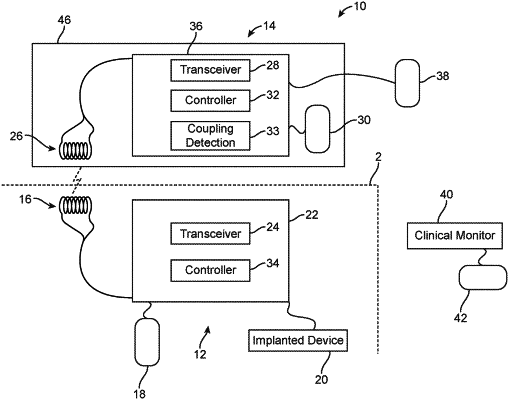| CPC A61N 1/3787 (2013.01) [A61N 1/37282 (2013.01); A61M 2205/18 (2013.01); A61M 2205/8206 (2013.01); A61M 2205/8243 (2013.01)] | 20 Claims |

|
1. A transcutaneous energy transfer system comprising:
an internal component adapted to be disposed within a body of a patient, the internal component comprising:
an internal coil;
an internal power source electrically connected to the internal coil and adapted to receive power from the internal coil;
an implantable device electrically connected to the internal power source; and
internal circuitry comprising an internal transceiver adapted to send and receive signals representative of one or more parameters relating to operation of the internal component; and
an external component adapted to be disposed outside the body of the patient, the external component comprising:
an external coil;
an external power source electrically connected to the external coil; and
external circuitry electrically connected to the external power source and the external coil, wherein the external circuitry comprises an external transceiver and an external controller, wherein the external transceiver is adapted to communicate with the internal transceiver and send and receive the signals representative of the one or more parameters relating to operation of the internal component, and wherein the external controller is electrically connected to the external transceiver and adapted to:
determine whether the internal coil is electromagnetically disconnected from the external coil;
if the internal coil is electromagnetically disconnected from the external coil, then:
determine a reconnection time threshold based upon at least one of a power transfer efficiency value between the internal coil and the external coil, a charge state of the internal power source, or a power consumption value of the implantable device; and
output a charging alarm if a time interval when the internal coil is electromagnetically disconnected from the external coil exceeds the reconnection time threshold.
|